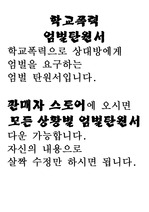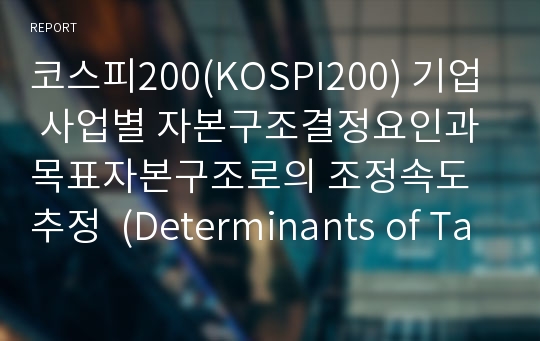코스피200(KOSPI200) 기업 사업별 자본구조결정요인과 목표자본구조로의 조정속도 추정 (Determinants of Target Capital Structure and Adjustment speed : Evidence from KOSPI200 listed firms by industry)
*찬*
다운로드
장바구니
목차
1. Introduction2. Methodology
3. Data
4. Empirical Test Results
5. Summary and Conclusions
6. Reference
본문내용
A variety of capital structure theory could be representatively divided into trade-off theory, pecking order theory, and market timing theory.Firstly, the pioneers of the trade-off theory are Modigliani and Miller (1963), who analyzed capital structure decisions in a model with taxes. The trade-off theory implies firms identify their optimal leverage by weighing the costs and benefits of an additional debt. That is, the companies increase debt levels until the marginal benefits of debt equals the marginal cost of debts. And, this point is optimal capital structure which maximizes firm value. For reference, benefit of additional debt is that firm can profit more from debt tax shields, which will increase its value. On the other hand, costs of additional debt are higher probability of financial distress and agency conflicts between stockholders and bondholders (Fama and French, 2002).
참고 자료
Antoniou, Antonios, Yilmaz Guney and Krishna Paudyal, 2008, The Determinants of Capital Structure: Capital Market-oriented versus Bank-oriented Institutions, Journal of Financial and Quantitative Analysis 43, 59-92Baker, Malcolm, and JeffreyWurgler, (2002), Market timing and capital structure, Journal of Finance, 57, 1–30.
Booth, l., Aivazian V., Demirguc-kunt a. and Maksimovic, V. (2001). Capital structures in developing countries, Journal of Finance, 56, pp87-130.
DeAngelo, H., and Masulis, R.W.(1980), Optimal capital structure under corporate and personal taxation, Journal of Financial Economics, 8, pp.3-29.
Dierker et al.(2013), Do Firms Adjust Capital Structure to Manage Risk?, Working paper
Donaldson G. (1961) Corporate Debt Capacity: A study of Corporate Debt Policy and the Determination of Corporate Debt Capacity, Boston, Division of Research, Harvard Graduate School of Business Administration
Fama, E., French, (2002), Testing trade-off and pecking order predictions about dividends, Review of Financial Studies, 15, p 1-33.
Flannery and Rangan(2006), Partial adjustment toward target capital structures, Journal of Financial Economics
Getzmann, A., Lang, S. and Spremann, K., (2010). 'Determinants of the target capital structure and adjustment speed-evidence from Asian capital market'. Working paper
Hass and Peeters (2006), The dynamic adjustment towards target capital structure of firms in transition economies, Economics of Transition Volume 14 (1) pp.133-169
Homaifar, G., J. Zietz and O. Benkato (1994), `An Empirical Model of Capital Structure: Some New Evidence', Journal of Business Finance & Accounting, Vol. 21, No. 1 (January), pp. 1-14.
Hovakimian, Opler and Titman(2001), The debt-equity choice, Journal of Financial and Quantitative Analysis, 36, 1-24
Jensen, M.,(1986), Agency costs of free cash flow, corporate finance and takeovers, American Economic Reviews, 76, pp 323-339.
Kang and Lee(2013), A Study on the Effects of Firm Size and Financial Constraints on Adjustment Speed of Capital Structure, The Korean Journal of Financial Engineering, Vol. 12, pp. 123~147
Kim H.S., A. Heshmati and D. Aoun (2006), “Dynamics of Capital Structure: The Case of Korean Listed Manufacturing Companies”, Asian Economic Journal 20(3), 275-303.
Modigliani, F, and Miller, M H,(1958) “The Cost of Capital, Corporation Finance, and the Theory of
Investment” American Economic Review, VO1.XLVIII, No.3, pp.261-97,
Modigliani, F. and Miller, M. H. (1963). Corporate Income Taxes and the Cost of Capital: A Correction. American Economic Review, 53, 433-43
Michael R. Roberts (2002), The Dynamics of Capital Structure: An Empirical Analysis of a Partially Observable System, Duke Working paper
Myers, SC, “The Capital Structure Puzzle” Journal of Finance VO1.XXXIX, No.3 (July 1984), pp.575-92
Ozkan, A. (1996), Corporate Bankruptcies, Liquidation Costs and the Role of Banks, The Manchester School, Vol. 64, pp. 104-19.
Ozkan, A. (2001). “Determinants of Capital Structure and Adjustment to Long Run Target: Evidence from UK Company Panel Data,” Journal of Business Finance & Accounting, 28, 175-198.
Rajan, R. and L. Zinglales, (1995), What do we know about capital structure? Some evidence from international data, Journal of Finance, 50, pp1421-1460.
Taggart(1977), A model of corporate financing decisions, Journal of Finance, Vol. 32. No.5 pp. 1467-1484
Titman, S. and R. Wessels(1988), The determinants of capital structure choice, Journal of Finance, 43, pp.1-19
Worthington, P.R.(1995), Investment, cash flow, and sunk costs, Journal of Industrial Economics, 43, pp.49-61


























